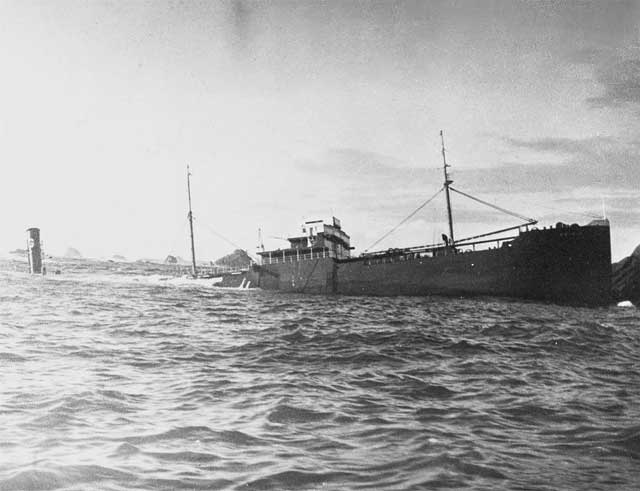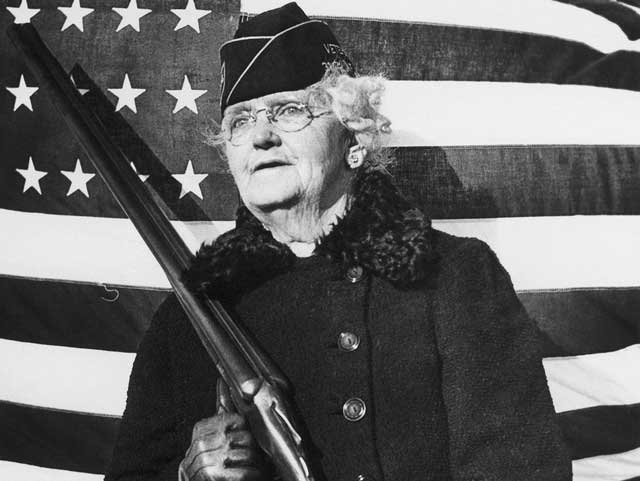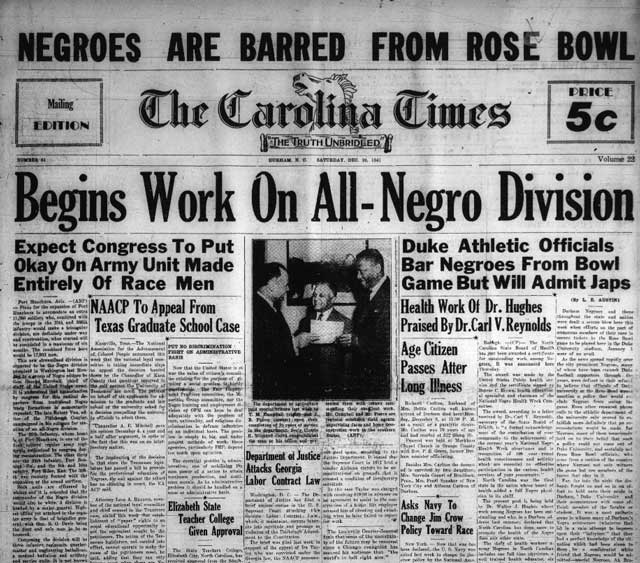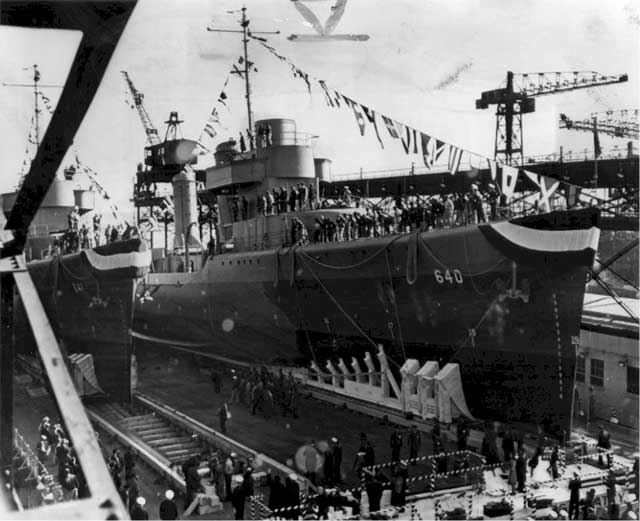Wednesday 24 December 1941
 |
| President Roosevelt addresses the crowd at the Christmas tree lighting ceremony from the White House South Portico on December 24, 1941. Winston Churchill, who is visiting during the Arcadia Conference, is at the right. This is the first Christmas Tree lighting ceremony ever held inside the White House grounds (FDR Presidential Library). |
Battle of the Pacific: On Hong Kong Island, the British situation is growing increasingly desperate by
24 December 1941. The Japanese have split the island in two at Wong Nai Chung Gap and control the entire island's water supplies, but the British and Canadian troops have greater worries, as reports of Japanese atrocities are growing. After dark, the Japanese approach St. Stephen's College, which is being used as a hospital on the front line, and massacre many injured men and doctors.
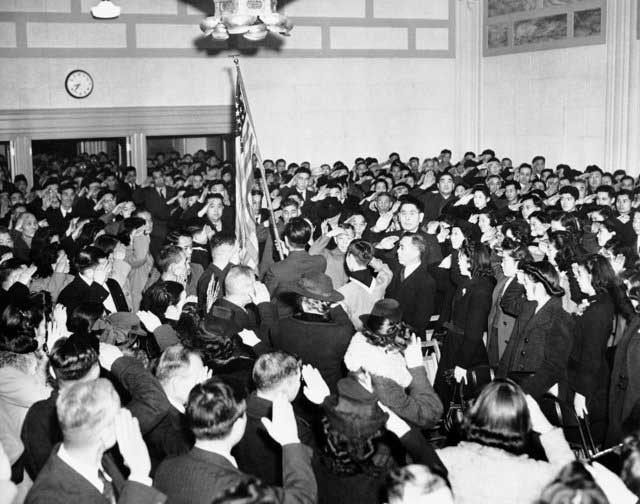 |
| About 1,300 Japanese Americans pledge their allegiance to the United States at a newly dedicated Buddhist church in Seattle, Washington, 24 December 1941 (The Associated Press). |
Massacres on Hong Kong Island are not isolated incidents, but the norm. For instance, during the closing days of the campaign the Japanese have:
- massacred around two dozen members of the 5th Anti-Aircraft Battery of the Hong Kong Volunteer Defense Corps (HKVDC) at Sai Wan Hill;
- killed many men at the Salesian Mission at Shau Kei Wan
- massacred eight Canadian soldiers after the battle of Jardine's Lookout;
- murdered three prisoners at Causeway Bay, including a female air raid warden with the local Air Raid Precautions (ARP);
- killed four soldiers at a house on Blue Pool Road known as the "Black Hole of Hong Kong," including two Canadian officers;
- massacred 30 civilians at Blue Pool Road;
- killed at least 47 British POWs at The Ridge;
- killed at least 14 prisoners at Overbays;
- killed 7 men at Eucliffe;
- killed an additional 36 men near The Ridge;
- possibly killed six soldiers of the Middlesex Regiment at Deepwater Bay Ride (it is unclear if they had surrendered);
- murdered eight or twelve British soldiers at the Maryknoll Mission;
- executed 26 prisoners at Brick Hill.
Other incidents are known to have happened because some men simply disappeared without a trace - meaning some perpetrators covered their tracks quite well.
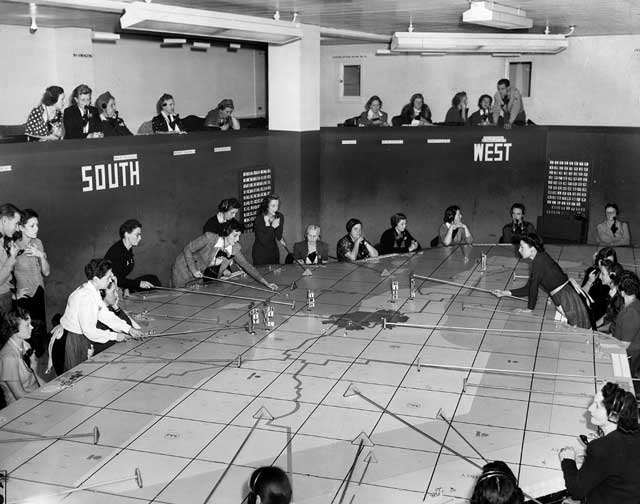 |
| Volunteers at a special station to coordinate Los Angeles air defenses in December 1941. Fears of a Japanese air attack on the city continue well into 1942. |
The most horrible atrocity on Hong Kong Island happens at St. Stephens, where an unknown number of victims variously estimated at from 13-99 are executed and then cremated. In the most notorious incident there, the Japanese rape three British and four Chinese nurses before killing them. Canadian Captain Overton Stark Hickey of the RCASC is shot while trying to help the nurses. The rest of the victims are doctors and wounded POWs (or at least patients who should have been treated as POWs). Unfortunately, the full scope of the St. Stephens massacre is impossible to prove later because the Japanese efficiently dispose of the evidence. Atrocities or not, the Commonwealth troops cannot hold out much longer on Hong Kong Island without water.
 |
| Damage caused by a Japanese air raid on the Manila port area. This photo was taken on 24 December 1941. |
In the Philippines, Lieutenant General Douglas MacArthur invokes War Plan Orange 3 (WPO-3) as he continues evacuating Manila. The WPO-3 plan calls for delaying actions in central Luzon while Allied forces retreat into the Bataan Peninsula. The 26th Cavalry Regiment attempts this difficult mission against overwhelming Japanese numerical strength under the command of South Luzon Force. The Americans begin using barges to move supplies from Manila warehouses into the Bataan in the hopes that it can be turned into a redoubt for US and Filipino soldiers and refugees.
 |
| Lt. Gen. Masaharu Homma, 14th Army commander, coming ashore at Lingayen Gulf, 24 December 1941. |
At dawn at Mauban on Lamon Bay southeast of Manila, the Japanese land the 2nd Battalion of the 20th Infantry Regiment (Lt. Col. Nariyoshi Tsunehiro). Other landings occur a little further south at Siain and Atimonan. The Philippine 1st Infantry Division is dug in at the Mauban beach and slows the Japanese down there. The invasion succeeds in getting three bridgeheads, however, and by nightfall, the Japanese have made good progress of about five miles inland at Mauban and even further advances at Atimonan and Siain. These landings put the Japanese within striking distance of the eastern approaches to the Bataan Peninsula. Maneuvering his forces to protect the exposed entry points in Bataan, MacArthur stations troops at San Fernando, the steel bridges at Calumpit over the Pampanga River, and Plaridel north of Manila. Admiral Thomas C. Hart sends the 4th Marine Regiment from Olongapo to Corregidor to secure it as the last bastion should the defense of Bataan fail. In the air, three B-17s based on Del Monte Field, Mindanao, raid Japanese shipping at Davao and then fly south to Darwin.
 |
| "Members of the gun crew overhauling their pom-poms while in the harbor." The Isaac Sweers in Alexandria Harbor, 24 December 1941. © IWM (A 7265). |
In the Malay Peninsula, Commander Australian Imperial Force Malaya, Major General Gordon Bennett (General Office Commanding Australian 8th Division), tries to organize a defense in depth. The Australian 27th Brigade Group, 8th Division occupies North Johore, while the Indian 11th Division (which controls all remaining Indian III Corps troops north of the Slim and Bernam Rivers) concentrates around Kampar and along the Slim River. The British are hampered by dwindling air support and the Japanese are becoming dominant in the air.
 |
| The United States Navy is still determining the extent of the damage at Pearl Harbor from the raid on 7 December 1941. Shown is damage to US Navy light cruiser USS Helena (CL-50) at left, with construction materials to fix it. This photo was attached to the 14th Naval District report, serial 01451 of 24 December 1941 (Naval History and Heritage Command). |
Japanese submarine attacks against US shipping along the west coast of the United States continue. Japanese submarine I-19 (some sources say I-17) surfaces and shells 5695-ton US freighter Absaroka about 19 nautical miles (36 km) northwest of Catalina Island, while I-23 does the same to 2119-ton US freighter Dorothy Philips off Monterey Bay south of San Francisco. Meanwhile, at Midway Island, US Marines of Batteries A and C of 4th Defense Battalions land after a hazardous journey aboard seaplane tender USS Wright.
 |
| "Commander Houtsmuller, Captain of HNMS ISAAC SWEERS coming on board his ship." Alexandria, 24 December 1941. © IWM (A 7262). |
In Borneo, the Dutch send Martin B-10 bombers against the Japanese forces that took Kuching late on 23 December. The Dutch withdraw their aircraft from Singkawang, Borneo, to Palembang, Sumatra, but they still hold Kuching Airfield because the Japanese forces close by haven't spotted it yet. The British "SARFOR" (Sarawak Force) garrison of Kuching, composed of just over 1000 men of the 2nd Battalion, 15th Punjab Regiment and the 35th Fortress Company and about 1500 local tribesmen, begins a delaying action as it moves inland toward Dutch Borneo. The Japanese main objectives are the oilfields at Miri and Seria and the refinery at Lutong.
 |
| Luftwaffe reconnaissance of Malta, 24 December 1941 (Federal Archive Bild 168-116-012). |
Battle of the Mediterranean: The Germans secretly evacuate Benghazi on 24 December 1941. Later in the day, the 7th Armored Division of the XIII Corps, British Eighth Army attacks the city and is pleasantly surprised to find it deserted. Troops of the Royal Dragoons are given the honor of being the first into Benghazi. Off Alexandria, U-568 (Kptlt. Joachim Preuss) torpedoes and sinks 925-ton Royal Navy corvette HMS Salvia (K-97) about 104 nautical miles (193 km) northwest of Alexandria. All 106 men aboard the British ship, which has been returning to base with convoy TA-5, perish.
 |
| A Christmas Eve service somewhere in the Soviet Union, 24 December 1941 (Federal Archive Bild 169-0875). |
Eastern Front: The lingering feud between the commander of Army Group Center, Field Marshal Guenther von Kluge, and General Guderian, commander of 2nd Panzer Army, continues to simmer. Kluge complains to the OKH operations chief, General Franz Halder, about Guderian allowing the 296th Infantry Division to withdraw even further than first thought without orders (and thereby saving it). In addition, Kluge notes that Guderian has pulled 47th Panzer Corps back as well in defiance of Hitler's stand-fast orders. When Halder suggests that Guderian should be court-martialled, Kluge equivocates, rationalizing that the withdrawals had been done "under the compulsion of circumstance." Halder himself then sends a direct order to Guderian to stop the withdrawals, send a division to Belev, and report in detail his troop locations before Hitler's midnight conference.
 |
| "German Luftwaffe pilot Erbo Graf Von Kageneck, holder of the Knight's Cross of the Iron Cross with Oak Leaves, standing in front of his Messerschmitt Bf 109 E whilst being assisted by two ground crew personnel. Von Kageneck, responsible for the destruction of 69 allied aircraft, was later shot down by RAAF pilot, Flying Officer Clive R Caldwell, (who was attached to 250 Squadron, Royal Air Force) on the afternoon of 24 December 1941 near Derna in Libya. Kageneck later died in a Luftwaffe hospital in Naples. Australian War Memorial P00323.001. |
While there is a lot of drama behind the scenes on the German side, things aren't much better at the front. Second Army, which is holding the line to Guderian's immediate right, has to withdraw along with Guderian's troops in order to not expose its own flank. The lack of reserves near the front compels these kinds of reflexive movements when one unit begins to retreat. There is blowing snow and low visibility, and nobody is really sure where any other units are. He announces that he will abandon Novosil and Livny, also in defiance of Hitler's orders. Before midnight, Guderian responds to a telephoned order from von Kluge to stop his retreat by requesting to be relieved and court-martialed. Kluge immediately gets on the phone to Halder and tells Halder, while apologizing for "ruining your Christmas spirit, which probably was not very rosy anyway." Halder then passes this information on to Hitler in East Prussia, who is just about to begin his midnight command conference.
 |
| You can catch a special Christmas Eve 24 December 1941 train/steamer combo From Boston to Vineyard Haven on Martha's Vineyard if you catch the 17:00 train. |
December 1941December 1, 1941: Hitler Fires von RundstedtDecember 2, 1941: Climb Mount NiitakaDecember 3, 1941: Hints of Trouble in the PacificDecember 4, 1941: Soviets Plan CounteroffensiveDecember 5, 1941: Soviets Counterattack at KalininDecember 6, 1941: Soviet Counterattack at Moscow BroadensDecember 7, 1941: Japan Attacks Pearl HarborDecember 8, 1941: US Enters World War IIDecember 9, 1941: German Retreat At MoscowDecember 10, 1941: HMS Prince of Wales and Repulse SunkDecember 11, 1941: Hitler Declares War on USDecember 12, 1941: Japanese in BurmaDecember 13, 1941: Battle of Cape BonDecember 14, 1941: Hitler Forbids WithdrawalsDecember 15, 1941: The Liepaja MassacreDecember 16, 1941: Japan Invades BorneoDecember 17, 1941: US Military ShakeupDecember 18, 1941: Hitler Lays Down the LawDecember 19, 1941: Brauchitsch Goes HomeDecember 20, 1941: Flying Tigers in ActionDecember 21, 1941: The Bogdanovka MassacreDecember 22, 1941: Major Japanese Landings North of ManilaDecember 23, 1941: Wake Island Falls to JapanDecember 24, 1941: Atrocities in Hong KongDecember 25, 1941: Japan Takes Hong KongDecember 26, 1941: Soviets Land in the CrimeaDecember 27, 1941: Commandos Raid NorwayDecember 28, 1941: Operation Anthropoid BeginsDecember 29, 1941: Soviet Landings at FeodosiaDecember 30, 1941: Race for BataanDecember 31, 1941: Nimitz in Charge2020













